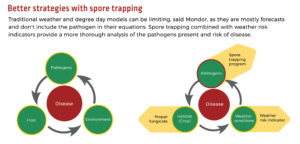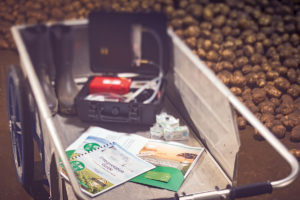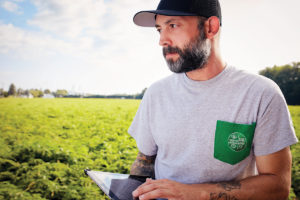
Preventing disease by capturing spores
Crop disease battles are a constant, and fungal pathogens can be a force to be reckoned with, particularly as inputs remain costly and pathogens build resistance.
With a four- to 10-day turnover from spore to disease and an outbreak in the field, and another four to seven days for symptoms, preventative measures could mean everything for averting outbreaks and crop loss.
“Producers need something quick, knowing that there’s a short latency period,” said Daniel Mondor, development and strategy director, AIR Spore.
Traditionally, spore capture has been done with a nonportable, fixed device, with a stick-like piece that turned on its own to collect spores. These analyses are done with biochemical identification — polymerase chain reaction, or PCR — testing, which require more manipulation, more money and more time to deliver the report. Then, producers can call to get their reports about 1.5 weeks after the sampling or after the media is collected, Mondor said about tests targeting late blight.
Spore capture technology has been around for decades, but only recently has the technology moved out of a relatively exclusive space of research and literature from universities and organizations and into a farmer’s field for a much lower cost. AIR Spore, in particular, had this technology available, but it was mostly used in the residential space. Being located near potato growers on the Atlantic Coast of Canada, the company was asked if it could detect fungus in a potato field like they could inside homes.
It was an interesting proposition, and the lab set out to put together a protocol.
“There’s no magical answer and no ultimate tool for what you need,” said Mondor. “Knowing what you’re looking for, you develop the technology as per the equipment depending on that need.”

The goal was to develop a measuring gauge in order to see the level of risk in real time, based on scientific data and without much paperwork. It had to be practical, something growers could use right away as an indicator and then get to work.
With the time that it takes for disease to develop, the program has become a two-week preventative action, particularly since symptoms are not always spotted right away in the field, instead of a corrective measure as with traditional spore capture.
“We wanted to provide a more preventive approach for financial imperatives, and also for sustainability, for soil health, labor and all these things that are related with spraying,” Mondor said.
Though other programs may vary, AIR’s spore capture program has a Monday, Wednesday, Friday sampling protocol when plants are roughly about 5-6 inches tall. The program uses a farm’s local lab, and reports are delivered the same day.
This can change the game of spore capture and disease prevention because farmers can get a much faster result that can determine if spray schedules should remain as is. For example, if a farmer plans to spray on Wednesday, but the report from Monday determines that there is no need to spray, sprays can be skipped. The same is true for an increase in disease risk or pressure — that spray protocol can be altered to tackle the disease before it has time to worsen.

timelines so growers can make informed decisions.
Farmers can heavily rely on classic weather or degree day models, but those models don’t typically include pathogens in their equations. They’re mostly forecasts, and that serves as the final piece to a larger farm picture and a more rigorous analysis, Mondor said.
The sampling equipment fits in what is about the size of a large suitcase. A tripod holds glass cassettes, and within those cassettes is a microscope slide with a bit of glue. It’s attached to a pump that operates a suction of about 15 liters per minute. It’s an active device, differing from its industry counterparts of netting or other passive materials dependent on the weather.
The spore collection operator goes to the field three times a week for about 15 minutes each.
It’s a turnkey program, said Mondor, complete with a weather station, which is beneficial for those who don’t even have support from the classic model of spore trapping. The weather risk indicator pulls its information from published disease literature, rounding out the report.
In Canada, there are regulations that are stricter than in the U.S., and some provincial governments are looking to create regulation that require this type of program. For the U.S., it could help to remove sprays from the schedule and help improve the bottom line.
“For a producer, it’s a tool that allows the management of fungicides as per the real need, based on scientific data, similar to what we do in insects and weeds,” said Mondor. “That way we have a threshold and can be more efficient and precise, and that can lead to a reduction in operation costs.”

Not only can cost reduction be the result of reduced spraying, but also the selection of lower cost products that can still get the job done. The reverse can be said, as well. In a high risk season, perhaps the crops need to be sprayed more to prevent disease.
In the 2022 season, Maine, Quebec and New Brunswick experienced outbreaks of late blight. In 46 sites in the same region that conducted spore trapping, the late blight spores were detected, but there was no disease outbreak due to taking preventative measures.
This particular spore program covers late blight, early blight, brown spot, gray mold, stem rot and oomycetes.
Photos and graphic: AIR Spore Program







